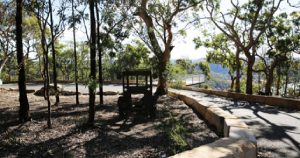
By Rob Cunneen
Last December, an exciting discovery was made at Wisemans Ferry, by the local historical society. It was the foundations of an early colonial building contemporary with Cobham Hall, which still exist on land belonging to Hornsby Shire Council.
An early survey dated 1831, shows that it is the site of the court house, office and residence of the surveyors (and magistrates) in charge of constructing the Great North Road, between the years 1826 and 1832.
It is a part of a suite of nearby convict sites, such as Devines’s Hill on the Great North Road, the Convict Stockades immediately above Wisemans Ferry, Finch’s Line and Warner’s Well. These have World Heritage, State and Local Heritage listings, whilst this site has none.
A thicket of lantana 2 to 3 metres high covered the whole site. Earlier in 2024, Hornsby Shire Council had begun a Bush Care project here, training local volunteers to slowly remove this weed. With the clearing of the lantana, the footings of this old building came to light.
Finished stone blocks from the walls had been repurposed as footpaths, and you can see some under the bucket. There is old lime mortar still between some of the blocks, with bits of shell visible in the mortar. Parts from an early colonial tobacco pipe which could be precisely dated to 1832-34, were also lying close inside this corner.
The photo above was taken in the 1880s, and appears to be in the same location. The background of hills and river flats places it close to the current Community Centre at Wisemans Ferry. It shows a stone building of some antiquity, labelled “Farm, Hawkesbury River, NSW” (Powerhouse Collection. Gift of Australian Consolidated Press under the Taxation Incentives for the Arts Scheme, 1985. Photograph attributed to Henry King.)
Although this background is bare of trees, and now the area is thickly forested, King was unmistakably photographing towards Rosevale from the site of the Community Centre. This building must be the Old Court House.
Although this is the best image we have, many other images survive. The Court House appears in a number of 19th century panoramic photographs of Wisemans Ferry, taken from across the river and atop the cliffs opposite Wisemans Ferry. And it is also in a scene painted by Conrad Martens in 1838, that currently hangs in one of the ground floor rooms of the NSW Art Gallery.
A careful inspection of the King photograph reveals that the house was already crumbling, and by 1920 it had disappeared from the contemporary panoramas – probably demolished.
Two years of bench records survive from the 1830s, recording the summary justice handed out to the convicts working on the road, or on the nearby farms.
And one of the magistrates – Lieutenant Percy Simpson – has actually left a description in the Sydney Herald of 13th June 1831, of the trial of convicts conducted in his own courthouse. Although Simpson was the presiding magistrate, he wrote as if he were an amused onlooker under an assumed pen-name “Fidelis”.
The Convict Trail Project hopes to organize a proper investigation of the site in the near future.







